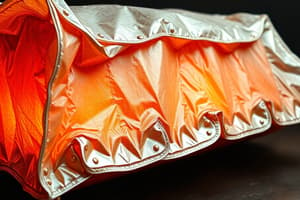Podcast
Questions and Answers
Which system of units is the most widely used in science and technology?
Which system of units is the most widely used in science and technology?
- Standard system
- Metric system
- Imperial system
- International System of Units (SI) (correct)
What is the process of converting a quantity from one unit to another?
What is the process of converting a quantity from one unit to another?
- Unit comparison
- Unit conversion (correct)
- Measurement
- Unit scaling
What are the seven base units of the SI system?
What are the seven base units of the SI system?
- Kilogram, meter, second, ampere, kelvin, mole, candela (correct)
- Pound, inch, gallon, minute, watt, degree, lumen
- Gram, liter, meter, second, joule, kelvin, candela
- Newton, meter, second, volt, kelvin, mole, candela
What determines the precision of a measurement?
What determines the precision of a measurement?
Which type of components can be further classified into passive, active, and discrete categories?
Which type of components can be further classified into passive, active, and discrete categories?
Which type of measurement uses a satellite to measure Earth's surface temperature?
Which type of measurement uses a satellite to measure Earth's surface temperature?
What are the building blocks of a system in science and engineering?
What are the building blocks of a system in science and engineering?
What is the process of assigning numerical values to physical properties or characteristics of objects or systems known as?
What is the process of assigning numerical values to physical properties or characteristics of objects or systems known as?
Which of the following are examples of continuous quantities?
Which of the following are examples of continuous quantities?
What can components be classified based on?
What can components be classified based on?
Study Notes
Components, Quantities, and Units
Introduction
Components, quantities, and units are fundamental concepts in the field of science and engineering. Understanding these concepts is essential for accurately measuring and quantifying physical phenomena. In this article, we will explore the types of components, measuring quantities, conversion of units, SI units, and significant figures.
Types of Components
Components are the building blocks of a system. They can be physical objects, such as resistors, capacitors, and transistors, or abstract entities, such as signals, data, and algorithms. Components can be classified based on their function, material, size, and other characteristics. For example, electronic components can be divided into passive components (resistors, capacitors, inductors, and transformers), active components (transistors, diodes, and operational amplifiers), and discrete components (diodes, transistors, and integrated circuits).
Measuring Quantities
Measuring quantities is the process of assigning numerical values to physical properties or characteristics of objects or systems. Quantities can be continuous (like length, temperature, and mass) or discrete (like count of items or numbers of categories). There are various methods to measure quantities, including direct measurements (using a ruler to measure length), indirect measurements (using a thermometer to measure temperature), and remote sensing (using a satellite to measure Earth's surface temperature).
Conversion of Units
Conversion of units is the process of converting a quantity from one unit to another unit. This is often necessary when comparing, combining, or converting quantities from one system of units to another. For example, converting from meters to kilometers, or from pounds to grams. Unit conversion can be done using simple multiplication and division, and some conversions can be done using factors or scaling.
SI Units
The International System of Units (SI) is the most widely used system of units in science and technology. The seven base units of the SI system are the kilogram, meter, second, ampere, kelvin, mole, and candela. Derived units are formed by combining base units using the mathematical operations of multiplication and division. The fundamental units of the SI system are chosen to be those which are independent of all other physical phenomena.
Significant Figures
Significant figures are those figures in a number that are used to express the precision of the measurement. The number of significant figures determines the precision of the number. For example, 1000 has 4 significant figures, while 100 has 3 significant figures. The number of significant figures is determined by counting the number of significant digits, which are the digits that indicate the precision of the measurement. Non-significant digits are those that indicate an uncertainty in the measurement.
Conclusion
Understanding components, quantities, and units is essential for accurately measuring and quantifying physical phenomena. By learning about the types of components, measuring quantities, conversion of units, SI units, and significant figures, you can better appreciate the importance of these concepts in various fields of science and engineering.
Studying That Suits You
Use AI to generate personalized quizzes and flashcards to suit your learning preferences.
Description
Test your knowledge of fundamental concepts in science and engineering including components, measuring quantities, unit conversion, SI units, and significant figures. Explore the types of components, methods for measuring quantities, conversion of units, the SI system, and the significance of significant figures.




